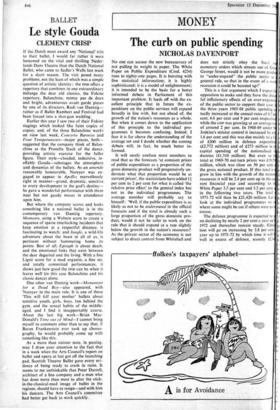BALLET
Le style Gouda
CLEMENT CRISP
If the Dutch must award any 'National' title to their ballet, I would far rather it were bestowed on the vital and thrilling Neder- lands Dans Theatre than the Dutch National Ballet, who came to Sadler's Wells last week for a short season. The visit posed many
problems, not the least of which was a simple question of artistic identity: the DNB offers a
repertory that combines in one extraordinary melange the dear old classics, the Fokine repertory, Balanchine, mimsy pas de deux and bright, adventurous avant garde pieces by one of its directors, Rudi van Dantzig- rather as if Ballet Rambert and Festival had been forced into a shot-gun wedding.
Earlier this year I saw two of their Fokine stagings which looked like faint copies of copies; and, of the three Balanchine works
on view last week, Concerto Barocco. and Four Temperaments—major pieces, both—
suggested that the company think of Balan- chine as the Prunella Stack of the dance, providing artistic exercise for the fuller figure. Their style—clouded, indecisive, in- effably Gouda—sabotages the atmosphere and dynamics of the ballets. As an amende reasonably honourable, Nureyev was en- gaged to appear in Apollo; marvellously right in manner—grand, dramatic, sensitive to every development in the god's destiny— he gave a wonderful performance with three neat but not gaudy muses in attendance upon him.
But where the company scores and looks something like a national ballet is in the contemporary van Dantzig repertory.
Moments, using a Webern score to create a sequence of sparse interlocking incidents that keep emotion at a respectful distance, is fascinating to watch; and Jungle, a wild-life adventure about the beast in all of us; is pertinent without hammering home its points. Best of all, Epitaph is about death, and the emotional links that exist between the dear departed and the living. With a fine Ligeti score for a mad organist, a fine set, and totally committed performances, it
shows just how good the DNB can be when it leaves well (in this case Balanchine and his classic dance) alone.
One other van Dantzig work—Monument for a Dead Boy—also appeared, with
Nureyev in the main role. It is one of those 'This will kill your mother' ballets about sensitive youth, girls, boys, fun behind the gym. and the sexual habits of the middle- aged, and I find it insupportably coarse. About the last big work—Brian Mac-
Donald's Time out of Mind—I cannot bring myself to comment other than to say that, if Baron Frankenstein ever took up choreo- graphy, he would probably come up with something like this.
As a more than sinister note, in passing, may I draw your attention to -the fact that in a week when the Arts Council's report on ballet and opera at last got off the launching pad, Scottish Theatre Ballet gave every evi- dence of being ready to crash in ruins. It seems to me unthinkable that Peter Darrell, architect of a fine company and a man who has done more than most to alter the stick- in-the-classical-mud image of ballet in the regions, should have to resign—and with him his dancers. The Arts Council's committee had better get back to work quickly.














































 Previous page
Previous page